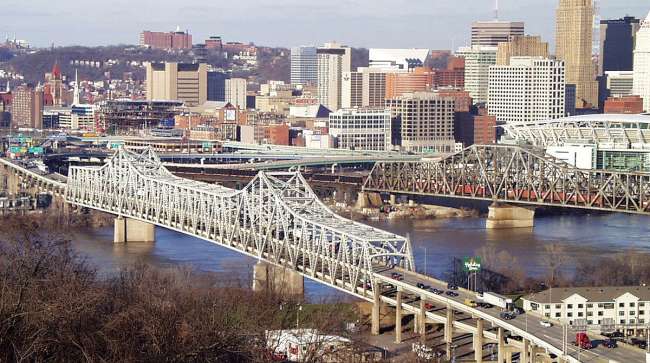Staff Reporter
Dashboard Tracks Federal Infrastructure Grant Use

[Stay on top of transportation news: Get TTNews in your inbox.]
Midwestern cities are spending more federal infrastructure grants to improve roads and bridges while Northeastern ones are funding the least, according to a new National League of Cities dashboard tracking $13 billion in projects across the nation.
The NLC’s interactive web dashboard, unveiled Sept. 14, offers numerous ways to look at how federal funds are being spent. Projects can be viewed by locality, state, congressional district, category type, program name and population size.
It also features a U.S. map with colored dots representing direct infrastructure funding awarded to local governments for investments in resilience, safety and clean energy as well as roads, bridges, public transportation and other infrastructure used by 97 million people.
The municipalities are grouped into four categories: city, town, village and city-county or equivalent. The dashboard has color coding by region and consists of 1,162 local governments. It is tracking $13 billion in bipartisan infrastructure law funding being spent on 1,647 projects throughout the United States.
Want to see how federal investments are shaping up our local communities? Check out NLC's new "Rebuilding America dashboard" to see real-time updates on federally-funded infrastructure projects happening right now: https://t.co/XFfuY0yVPW — National League of Cities (@leagueofcities) September 14, 2023
Clarence Anthony, NLC CEO and executive director, said, “Our new dashboard demonstrates all of the remarkable ways cities, towns and villages are putting these historic federal funds to work in their communities.”
The dashboard shows that while states across the country are spending more (41%) of their total federal infrastructure dollars to fund major projects such as roads and bridges, the Midwest is outpacing everyone with 17% of its expenditures on such improvements.
The other areas of the country are allocating single digits of their share of federal funds to improve roads and bridges: the South at 9%, the West with 8% and the Northeast/Mid-Atlantic in last place with 7%.
Check out the tracker here. (National League of Cities)
When selecting the roads and bridges category, the city topping the list by spending the most is Cincinnati, with a $1.385 billion bridge grant on a massive project to improve the Brent Spence Bridge.
Next is Chicago, which received $144 million from the bridge investment program to rehabilitate the Illinois International Port Calumet River Bridges, $117 million in megaproject funds for the Metra Union Pacific north to rebuild 11 railroad bridges that are 120 years old, and $20 million in local and Regional Project Assistance Grants to convert an abandoned railway corridor into the Englewood Nature Trail.
The Calumet bridges project, which received the grant in January, is critical for allowing freight access via the waterways between Lake Michigan and the Gulf of Mexico through the Illinois International Port (an international hub) and the Illinois Waterway.
According to the Chicago mayor’s office, each bridge lifts an average of 5,000 times per year and carries a combined average of over 40,000 vehicles per day, of which 3,000 are trucks.
Want more news? Listen to today's daily briefing above or go here for more info
Other large amounts of federal dollars for roads and bridges are being spent by Bay City in Michigan. It is using a $73 million federal grant to help pay for replacing the antiquated Lafayette Avenue Bridge over the Saginaw River. The bridge, which carries over 16,000 vehicles daily, provides an important transportation link within Michigan’s Great Lakes Bay Region and is in poor condition.
When the federal grant was awarded in April, Sen. Debbie Stabenow (D-Mich.), remarked, “After 85 years of service, temporary closures and repairs, the replacement of the Lafayette Avenue Bridge is long overdue. Because of our passage of the federal infrastructure law, this investment will make this bridge safe for drivers and pedestrians for years to come.”




